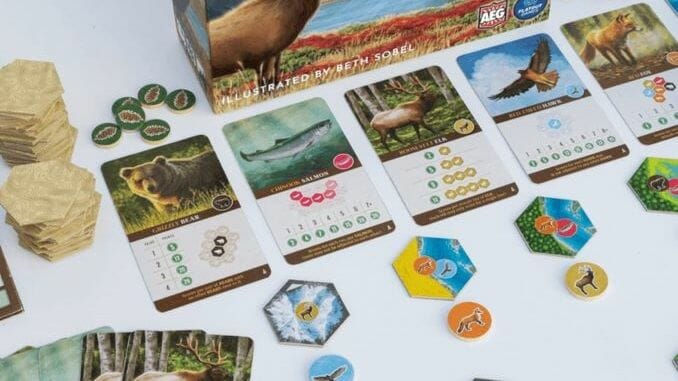Cascadia was my #3 new game of 2021 thanks to a combination of easy-to-learn rules and variable scoring methods, making it a solid family game that is meaty enough to satisfy more experienced gamers as well. It’s a game that not only rewards replaying, but makes you want to do so immediately because you realize all the other strategies you didn’t get to try the last time around.
Cascadia came out last summer from Flatout Games, the same studio that gave us the surprisingly complex game Calico the year before, with Cascadia a sort of “spiritual successor” to the first title. Calico looks cute and simple, with a theme built around cats and quilts, but the game itself presents a difficult challenge with tight scoring rules and an unforgiving structure—you have a board with a frame around it and have limited places to put hex tiles, with no chance to move them later if you make a mistake.
An early error can sink your entire game in Calico, but that’s not true in Cascadia, where you also place hex tiles but build your “environment” free-form on the table. Cascadia revolves around five animal types, which score differently from each other and can score differently from one game to the next; and five habitat types shown on those hex tiles, which always score the same way, with points for your largest area of each. On any turn, you will choose a hex tile/animal token pair from the market, which will always have four such pairs available. You place the hex tile adjacent to one already in your environment, and then place the animal token on any tile in your environment that shows that animal’s symbol. You don’t have to place the animal token on the tile you just took; that’s often illegal anyway, since the tile may not show that animal’s symbol. Every player will take 20 turns, thus placing 20 tiles and 20 animals, not counting the three-hex start tile with which you begin the game.
Some hex tiles only show a single animal type with a small pine cone icon on it. When you place the matching animal token on that tile, you get a nature token to use at any point later in the game. You may use it to take a hex tile and animal token from two different pairs in the market, or may use it to replace any of the animal tokens currently in the market with new ones taken randomly from the supply. Unused nature tokens are worth a point each at game-end, but their real value is in using them when you need something specific to complete an animal pattern or avoid a wasted move near the end of the game.
Once the last player has taken their 20th turn, exhausting the supply of hex tiles, you score animals and then habitats. Each animal has four scoring methods in the base game, which you can choose randomly or just select. The rules suggest using the “A” scoring methods for your first game, so just for an example, here’s how the five animal types score. Hawks score if they’re alone, not adjacent to any other hawks, and are worth three to five points apiece depending on how many you have. Bears score in mating pairs—yes, pairs of bears—and no, sorry, there are no ursine throuples in Cascadia. The more pairs, the more each is worth. Elk score for straight lines of up to five tokens, with more points the more tokens in each line. Foxes score one point for each distinct animal type adjacent to the fox, up to five points per fox token. Salmon score in runs, maxing out at seven salmon in a run for 25 points total. The B through D variants offer other ways to score, and the game comes with “family” rules where you score each animal the same way and try to get them in groups of three or four to max out your points.
The habitats score a little more simply, and they’re the same in every game. You score the largest contiguous area you have for each of the five habitat types, getting one point per tile included in that area. The player with the largest area out of all players for each type gets a bonus depending on the player count. Add in the points for unused nature tokens and you’ve got your winner.
Other than the difficulty you might have with some of the scoring methods for animals, there’s very little learning curve in Cascadia, even for folks who haven’t played a lot of games before—and I think the main challenge with the scoring is keeping five different scoring paradigms going in your head at once. You’ll probably focus on two or three of the animal types for most of your points, since an egalitarian strategy of getting four of each animal type is not only improbable but also a guaranteed loser. In fact, any strategy that pushes for two specific animal types is likely to make the player competitive, so even younger or novice players can jump right in and play well the first time out—the mark of a great family-level game. It also comes with a solo mode that plays pretty well, removing tile/token pairs from the market after each of your turns so you can’t always get what you want—although if you try, sometimes, well, you know the rest. Games take under an hour, and I’d guess you can meet the suggested time of 30 minutes shown on the box for two players who’ve played before. I’m all in on this game: it hits that sweet spot of accessibility and intellectual challenge that I most enjoy about this hobby.
Keith Law is the author of The Inside Game and Smart Baseball and a senior baseball writer for The Athletic. You can find his personal blog the dish, covering games, literature, and more, at meadowparty.com/blog.
